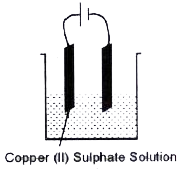Brine is electrolysed by using inert electrodes. The reaction at anode is_______
Cl−(aq)→12Cl2(g)+e−, EөCell=1.36V
2H2O(l)→O2(g)+4H++4e−, EөCell=1.23V
Na+(aq)+e−→Na(s), EөCell=2.71V
H+(aq)+e−→12H2(g), EөCell=0.00V
The correct Answer is:A
To determine the reaction at the anode during the electrolysis of brine using inert electrodes, we can follow these steps:
1. Understand the Composition of Brine:
- Brine is a concentrated solution of sodium chloride (NaCl) in water (H2O).
2. Identify the Electrolysis Process:
- During electrolysis, brine will dissociate into its ions: Na⁺ and Cl⁻ from NaCl, and H₂O will also dissociate into H⁺ and OH⁻ ions.
3. Determine the Reactions at the Electrodes:
- At the anode (positive electrode), oxidation occurs. We need to identify which species can be oxidized:
- Chloride ion (Cl⁻) can be oxidized to chlorine gas (Cl₂).
- Water (H₂O) can be oxidized to oxygen gas (O₂).
4. Write the Possible Reactions:
- The possible reactions at the anode are:
- Oxidation of Chloride:
2Cl−(aq)→Cl2(g)+2e−
- Oxidation of Water:
2H2O(l)→O2(g)+4H+(aq)+4e−
5. Compare Standard Electrode Potentials:
- The standard electrode potentials for these reactions are:
- For Cl⁻ to Cl₂: E∘=+1.36V
- For H₂O to O₂: E∘=+1.23V
6. Determine Which Reaction is Preferred:
- Generally, the reaction with the lower standard electrode potential is preferred for oxidation at the anode. However, due to kinetic factors (overpotential), the reaction with the higher potential (Cl⁻ to Cl₂) occurs more readily in this case.
7. Conclusion:
- Therefore, the reaction at the anode during the electrolysis of brine is:
2Cl−(aq)→Cl2(g)+2e−
Final Answer:
The reaction at the anode is:
2Cl−(aq)→Cl2(g)+2e−
- Brine is a concentrated solution of sodium chloride (NaCl) in water (H2O).
- During electrolysis, brine will dissociate into its ions: Na⁺ and Cl⁻ from NaCl, and H₂O will also dissociate into H⁺ and OH⁻ ions.
- At the anode (positive electrode), oxidation occurs. We need to identify which species can be oxidized:
- Chloride ion (Cl⁻) can be oxidized to chlorine gas (Cl₂).
- Water (H₂O) can be oxidized to oxygen gas (O₂).
- The possible reactions at the anode are:
- Oxidation of Chloride:
2Cl−(aq)→Cl2(g)+2e−
- Oxidation of Water:
2H2O(l)→O2(g)+4H+(aq)+4e−
- The standard electrode potentials for these reactions are:
- For Cl⁻ to Cl₂: E∘=+1.36V
- For H₂O to O₂: E∘=+1.23V
- Generally, the reaction with the lower standard electrode potential is preferred for oxidation at the anode. However, due to kinetic factors (overpotential), the reaction with the higher potential (Cl⁻ to Cl₂) occurs more readily in this case.
- Therefore, the reaction at the anode during the electrolysis of brine is:
2Cl−(aq)→Cl2(g)+2e−
The reaction at the anode is:
2Cl−(aq)→Cl2(g)+2e−
Topper's Solved these Questions
- GENERAL PRINCIPLE AND PROCESSES OF ISOLATION OF ELEMENTS BOOK - NCERT EXEMPLAR ENGLISHCHAPTER - GENERAL PRINCIPLE AND PROCESSES OF ISOLATION OF ELEMENTS EXERCISE - Short answer type Question
18 Videos
- GENERAL PRINCIPLE AND PROCESSES OF ISOLATION OF ELEMENTS BOOK - NCERT EXEMPLAR ENGLISHCHAPTER - GENERAL PRINCIPLE AND PROCESSES OF ISOLATION OF ELEMENTS EXERCISE - Matching The columns
5 Videos
- ELECTROCHEMISTRYBOOK - NCERT EXEMPLAR ENGLISHCHAPTER - ELECTROCHEMISTRYEXERCISE - All Questions
67 Videos
- HALOALKANES AND HALOARENESBOOK - NCERT EXEMPLAR ENGLISHCHAPTER - HALOALKANES AND HALOARENESEXERCISE - Long Answer Type Questions
3 Videos
Similar Questions
When molten NaCl is electrolysed by using inert electrode, the product obtained al cathode is
View SolutionA solution of sodium sulphate in water is electrolysed using inert electrodes, The products at the cathode and anode are respectively.
View SolutionAn aqueous solution of CuSO4 is electrolyzed using Pt electrodes in one case and Cu electrodes in another case. What are the products of electrolysis in both the cases ?
View SolutionAqueous solution of NaCl containing a small amount of MeOH ( methyl orange ) is electrolysed using Pt− electrodes . The color of the solution after some time will .
View SolutionA dilute aqueous solution of CuSo4 is electrolysed using platinum electrods. The products at the anode and cathode are:
View SolutionAn aqueous solution of Na2SO4 is electrolysed using Pt electrodes. The products at the cathode and anode are respectively:
View SolutionA solution of sodium sulphate was electrolyzed using some inert electrode. The product at the electrodes are
View SolutionA dilute aqueous solution of Na2SO4 is electrolyzed using platinum electrodes. The products at the anode and cathode are :
View SolutionCopper sulphate solution is electrolysed using copper electrodes. Study the diagram given below and answer the question that follows:

Write the equation representing the reaction that occurs.
View SolutionCopper sulphate solution is electrolysed using copper electrodes. Study the diagram given below and answer the question that follows: Which electrode to your left or right is known as the oxidising electrode and why?

View Solution
